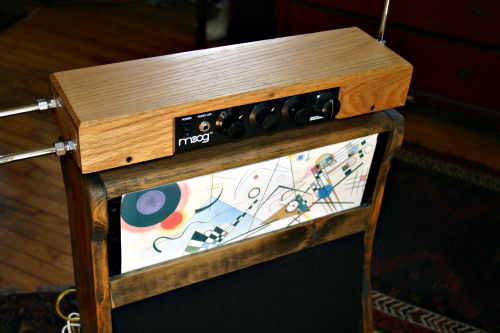A 365-Day Project
"We Are All Mozart"
A project to create
new works and change
the perception of the
music of our time.


 September 1, 2006
September 1, 2006 
The theremin is on my mind again -- mostly in terms of why it failed. Despite the dedicated work of the late Robert Moog and his Ethervox, the theremin's repertoire comes in basically three forms: fun stuff, woo-woo, and romantic recidivism. There are others (my own LiquidBirds is among them), but most performances treat the theremin as a toy instrument (just search YouTube for hundreds of examples including my white bicycle (godspeed)), employ it for science-fiction or mysterious effects, or use it to emulate the string lushness first advocated by Clara Rockmore under the tutelage of the instrument's inventor, Lev Termen.
It's been said that Termen's traditional ambitions for his instrument were due to his having been born in the Romantic era -- that 1896, the year of Termen's birth, overlapped with the lives of Brahms, Verdi, Saint-Saëns, Dvořák, Mahler and Puccini. But in fact, Termen was born late. One composer who would shake up the Twentieth Century, Arnold Schoenberg, was born 22 years before Termen, with Schoenberg's Pierrot Lunaire and its sliding Sprechstimme written in 1912, well before the theremin even existed. Termen's groundbreaking countryman Igor Stravinsky was born in 1882, with Rite of Spring and its mysterious glissandi heard in 1913, still well before the theremin. Edgard Varèse (occasionally lauded as the "father of electronic music") was born in 1883, with Amériques finished by 1921. Henry Cowell (who commissioned the Rhythmicon from Termen) was the inventor's contemporary, born in 1897. Even the late-breaking Harry Partch, another instrument creator with alternate tunings and sliding instruments like the Crychord, was born just five years after Termen in 1901.
All these composers found dramatic new ways of working with a body of traditional instruments or devising new ones. Termen invented his instrument well after the cultural shift away from Romanticism was effectively complete; even the hyper-conservative Sergei Rachmaninoff's largest body of Romantic works was written before then, with the big-handed pianist largely abandoning composition after 1918.
So Termen was not a child of the Romantic era. He was a child during the Postromantic era, a period of great artistic change and political turmoil. Artists in every medium pulled themselves out of the Romantic milieu before the theremin existed in 1919. Yes, one can remember that Theremin was an engineer, and even today many engineers prefer their nonpop recreation with "orderly" music like Bach and Mozart. And one also can point to misplaced marketing in America. There are lots of excuses, but few beyond the reality that Termen did not advocate for what his instrument did natively, despite composers and performers eager to exploit new sounds and techniques abounding during that artistic era.
There's also an initial excuse with respect to the 1911-born Rockmore, if one wishes to use it. As a child prodigy playing established repertoire with her conservative elder sister Nadia Reisenberg (born in 1904), she would have been shielded inside the Romantic bubble, as most instrumental prodigies of the time would have been -- until physical problems wrecked her future as a violinist. And so not unexpectedly, after the sixteen-year-old fell under Termen's handsome spell in 1927, she transposed violin to theremin, effectively bringing the pitch-based technique and pseudo-fingering from one continuous-tone-capable instrument to another, ignoring the remaining possibilities. She was frozen in her own Romantic past at a very young age, even while choosing the non-Romantic theremin.
The Termen-Rockmore partnership was intense. According to Peter Pringle, "It is easy to understand why Leon Theremin, the inventor of the instrument that bears his name, was deeply in love with Clara. Apart from being brilliantly talented as a musician and thereminist, she was strikingly beautiful. According to Clara, Leon Theremin proposed to her several times but she refused his offers of marriage."
Termen had made a new and very non-traditional instrument -- yet couldn't find new ways to use it. What happened? In part, what happened was his exploitation of a Romantically trained child as his acoustic amanuensis, and Communism. Termen's political decision was to stay in the new Soviet Union. Rachmaninoff chose self-exile; so did Stravinsky. Shostakovich didn't -- but within Stalinist restrictions, he reinvented a marvelously convoluted Postromanticism à la Soviet Realism. Lenin is said to have financed Termen's travels, and according to Termen himself, a good performance of Glinka's Skylark on the theremin made that possible.
One might also ask if this push backwards (in the case of the theremin, to romanticism) is an unavoidable circumstance for the human brain, if it is hardwired to prefer certain sounds in music that the theremin could not fulfill in its native state of sliding pitch. Thereminist Pringle points out, "Bone flutes from a number of different and unrelated societies that date back well into prehistoric times, and that can still be played today, would indicate that we have enjoyed 'distinct pitches' for a heckuva long time."
True though Pringle's historical note is, it does not balance the strong expectation for non-specific and unpitched elements in sound. Our very speech is based on continuous pitch changes and filtering; we omit the former when we want to 'sound like computers'. Manfred Clynes indeed makes the case for sliding tones as the basic elements of emotional and musical interchange. Vibrato and portamento are right there among basic musical techniques as well, and where would we be without the whole panoply of unpitched percussion?
This is not an argument against pitch specificity, but rather one pointing out the tendency to reject the invitation to an instrument's unique capability in favor of emulation of other instruments. It may be an expected behavior of non-musicians or traditional musicians, but for Termen himself to effectively smother the instrument in the cradle of exploration hindered its adoption on its own merits.
That result cannot be mitigated, at least for now, especially with the hagiography of Termen and Rockmore (and now Moog) within the theremin community. All one need do is listen to the bulk of theremin repertoire to hear the acoustic shadows of 'beloved' Lev and Clara. The pair did inestimable damage to the theremin's potential by forcing Termen's brand-new invention into a Romantic-era mold where The Swan was its anthem. The Rockmore-promoted approach of playing the theremin as an air cello is not unique, however. Faced with vast options during the early era of the synthesizer, companies had a similar knee-jerk reaction, turning the synth into a fancy organ by sticking on keyboards identical to the centuries-old model. Midi (an industry-promoted standard) followed that limited path not only by making 12 fixed pitches the default, but also making other options immensely difficult to implement.
It's not that traditional structures were inherent to the synth concept. Rather, economics marginalized their wider capabilities. It was a choice among engineers and marketers in part to make the synth emulate a keyboard's ability to play multiple notes at once -- implying harmony, implying pop, and implying cash. The stick-on keyboard certainly wasn't used for harmony at the beginning, because early instruments were monophonic. Indeed, keyboards supported and encouraged multiple pitches only after they were added, and technology had caught up with that.
But with few exceptions (such as the Ionic synth from 1973), later instruments did not continue to support different numbers of pitches per octave, and Midi itself was the death knell for easily implemented alternate tunings (even those alternate tunings used by, say, Byrd or Couperin hundreds of years before) and continuous pitches. My fourteen-year-old Midi-based Emu Proteus Plus Orchestral actually had several alternate tuning systems built in, but it was among the last synths to do so. I don't even know if you can buy one off the shelf today where you can simply dial in "Valotti" or turn on quarter-tones as a native setting (quarter-tones as used by, say, Charles Ives in his 1924 pieces -- right during the theremin's initial bloom).
What these companies do -- and this is the nature of capitalism's simultaneous argument with and benefit to artists -- is commoditize. Commoditization stays right in the middle of and contributes to the stasis of the bell curve, whereas art doesn't fear going out along several square roots of variance. (Interestingly, sampling synths have resurfaced with sliding and mutated pitches and other sounds in digital turntable hiphop and scratch, such as the CDScratch.)
Yet some performers, including Pringle, claim that those who take the standard pitch-based route to theremin playing are not "blind or closed to other possibilities. We do it because we love it."
I wonder, though, if this is not simply acculturation. Though I compose mostly pitch-based twelve-tone equal-temperament acoustic music (and at least one pitch-based theremin piece), my own experience is likely atypical. Without music or radio or tv or records in the house as a younger child, I missed the more ordinary childhood musical experience. I ended up with no sonic preferences. So having discovered pop and nonpop almost tabula rasa as a young teenager, I will not hesitate today to use whatever techniques and tools best express the music's character or the acoustic point to be made. So it is hard for me to judge the depth of this "love" of theremin playing on a standard pitch basis.
But it once again traces back to the inventor and his elegant musical companion. One has both to be willing and to be aware to look beyond the present. After the invention itself, the Termen/Rockmore marketing duo seems to have been neither, just a clever, handsome young engineer with a lucky find on his hands and a sad, pretty young girl whose violin-prodigy dreams had been dashed. Together they clearly made a formidable and fashionable pair, however, irrevocably imprinting the Romantic ideal on an electronic instrument with nary a Romantic electron to be found.
At the outset, my premise was to learn why the theremin failed. Perhaps it has not, and is merely waiting for the instrument to find its voice -- not in humor, mystery or romanticism, but perhaps in play with other electronic instruments or in acoustic-electronic improvisations. Or perhaps its time has come and gone, and it will fade again into curiosity. Suggestions, as ever, welcome.

My Moog Etherwave theremin was built from a kit, and the handmade stand uses a Kandinsky painting from the era the original instrument was promoted in America.